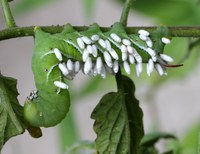Dakota Gardener: Beware of the Garden Glutton
(Click an image below to view a high-resolution image that can be downloaded)
By Tom Kalb, Horticulturist
NDSU Extension
Parents of teenagers often say, “My kids are eating me out of house and home. I can’t believe how much they eat.”
Just be glad you are not feeding a hornworm. They eat four times their weight - every day!
Imagine if your 150-pound teenage boy had the appetite of a hornworm and you took him to McDonalds. He would step up to the counter and order 600 Big Macs. Not six Big Macs, 600. That’s what I call a Big Mac attack!
He is just getting started. Next comes 600 large orders of french fries.
Add 100 side salads to the meal. After all, he must have a balanced diet.
For dessert, how about 100 ice cream cones? Fortunately, the restaurant offers reduced-fat ice cream.
We have to get tomatoes into this hornworm diet, so let’s add 1,000 packets of ketchup to slurp on.
It’s hard to eat four times your weight in one day, and tomorrow he will eat even more.
Tomato and tobacco hornworms (Manduca spp.) are amazing insects. Their scientific name Manduca means glutton. The 4-inch caterpillars eat so much, their guts burst out of their skins, requiring them to molt and shed their skins several times. They increase in size by more than 1,000 times in less than three weeks. That’s comparable to a cat growing to the size of an elephant.
Hornworms are the No. 1 insect pest of tomatoes in North Dakota. They are active now and can be found devouring tomato, eggplant, pepper and flowering tobacco plants.
You probably won’t notice hornworms in your garden until a tomato branch disappears overnight. The striped patterns of the caterpillar allow them to camouflage themselves within the vines. The caterpillars have scary “eyeballs” along the sides of their body and a horn on the end of their body to intimidate their enemies.
Once you notice one, a hornworm is easy to control. Grab it and throw it in a bucket of soapy water, or throw it on the ground and stomp on its guts. Gross, but effective.
While picking off hornworms, sometimes you will find one covered with ricelike grains. These white grains are the cocoons of parasitic wasps. Earlier, a female wasp laid her eggs inside the caterpillar. The eggs hatched and ate the guts inside the hornworm. What a way to die! It’s just like an “Aliens” movie.
Once done eating, each wasp larva spun a white cocoon on the outside of the hornworm to rest inside. New wasps will emerge out of these cocoons, ready to attack more hornworms and other pests in your garden.
Hornworms are fascinating, and grow-your-own hornworm nursery kits are available online. You can grow your hornworm to full size, watch it make a cocoon and later see it emerge as a moth. These hawk moths are so big, they are often mistaken for hummingbirds. Nature is cool!
For more information about gardening, contact your local NDSU Extension agent. Find the Extension office for your county at https://www.ag.ndsu.edu/extension/directory/counties.
NDSU Agriculture Communication - Aug. 4. 2020
| Source: | Tom Kalb, 701-328-9722, tom.kalb@ndsu.edu |
|---|---|
| Editor: | Ellen Crawford, 701-231-5391, ellen.crawford@ndsu.edu |




